The rehabilitation you will need after surgery for AVN depends entirely on what surgical procedure was performed. Obviously those procedures that are more complicated will require more intensive therapy at Eastwood Physiotherapy for a longer period of time. You may even need to be seen by an inpatient physiotherapist so you can start some exercises while you are still in the hospital.
After being discharged from the hospital you should begin physiotherapy at Eastwood Physiotherapy as soon as your surgeon allows. Some surgeons will recommend that you begin rehabilitation immediately, whereas others prefer that you wait until you are able to put a sufficient amount of weight through your surgical side.
After surgery for AVN you will be required to use a walking aid such as a walker or crutches. After a drilling operation, you will probably use the walker or crutches for six weeks or so. Due to the drill holes weakening the bone around the hip, fracturing the hip by putting too much weight on it is possible. Using a walking aid allows pressure to be taken off the bone while it heals and reduces the risk of fracturing your hip while the bone is healing. Patients who have had bone and blood vessels grafted are required to limit how much weight they place on the hip for up to six months.
If you are still using a walker or crutches by the time we first see you at Eastwood Physiotherapy, your physiotherapist will ensure you are using them safely, properly, and confidently while abiding by your weight bearing restrictions. With crutches we will ensure that you can safely use them on stairs. If you are no longer using a walking aid, or once you no longer need one, your physiotherapist will focus on normal gait re-education to ensure that you are putting only the necessary forces through the surgical side with each step, and are not compensating in any way. Until you are able to walk without a significant limp, we recommend that you continue to use a walking aid, such as your crutches, or a cane/stick. Improper gait can lead to a host of other pains in the knee, hip and back so it is prudent to use a walking aid until virtually normal walking can be achieved. Your Eastwood Physiotherapy physiotherapist will advise you, in conjunction with your surgeon’s protocol, regarding the appropriate time for you to be ambulating without any walking aid at all.
During your first few appointments at Eastwood Physiotherapy your physiotherapist will focus on relieving any pain and/or inflammation you may still have from the surgical procedure. They may use modalities such as ice, heat, ultrasound, or electrical current to assist with decreasing any pain or swelling you have around the surgical site or anywhere down the extremity. In addition, your physiotherapist may massage your hip, back, leg or ankle to improve circulation and help decrease your pain.
The next part of our treatment will focus on regaining the range of motion in your hip. Your physiotherapist at Eastwood Physiotherapy will prescribe a series of stretching exercises that you will practice in the clinic and also do as part of a home exercise program. You may experience a small amount of discomfort at the end ranges of motion initially, but despite this it is important to perform the range of motion exercises as prescribed because moving the joint also helps to move the swelling, get fresh blood to the healing areas, and provides nutrition to the joint. Only mild discomfort, however, is permissible. Any sharp or moderate discomfort should be heeded. An exercise bike at this stage of recovery can be very useful. Even if you are unable to fully rotate the pedals of the bike, the forwards and backwards motion still assists the joint nutrition and aids in gaining range of motion. Stretches for your knee, ankle and calf may also be necessary as these areas can become tight with the use of a walking aid.
If necessary, and as time and healing allows, your physiotherapist may mobilize your hip joint. This hands-on technique encourages the hip to move gradually into its normal range of motion. Mobilization of the hip may be combined with assisted stretching of any tight muscles around the surgical site.
Strengthening exercises are another important component of your post-surgical rehabilitation. Due to compensatory walking and movement patterns in response to pain it is common to develop a muscular weakness in certain muscles around the hip, and an overall muscular imbalance. Exercises will focus mainly on the muscles of your hip and thigh but your therapist will also include exercises for your back and core areas as they play a large supporting role for your hips. Exercises that involve the entire lower limb, such as squats on both legs at the same time, or just on one leg, will be prescribed. Exercises that work the muscles while in standing are most effective for improving daily activities such as walking and stair climbing. Other exercises in sitting or lying, however, may also be prescribed. Exercises in these non-weightbearing positions are excellent as they allow you to target specific muscles around the hip, such as the gluteals, even if you are not weightbearing on that side. Your therapist may use an electrical muscle stimulator to assist your muscles in contracting as you do your exercises; this will help you to more rapidly gain your strength back. Exercises may also include the use of Theraband or weights to provide some added resistance for your hip and lower extremity. If you have access to a pool, your therapist may suggest you go to the pool to do your exercises. As mentioned above, the buoyancy and hydrostatic properties of the water along with the warmth of the water (provided it is a heated pool) can assist greatly in providing comfort to the hip joint and often allows you to exercise within a greater range of motion.
As a result of any injury or surgery, the receptors in your joints and ligaments that assist with balance and proprioception (the ability to know where your body is without looking at it) decline in function. A period of decreased mobility and reduced weight bearing will add to this decline. When balance and proprioception has declined, your joints and your limb as a whole do not function as efficiently, and the decline may contribute to further injury in the future. Once you are able to put full weight onto your surgical side a final component of our treatment at Eastwood Physiotherapy will be to prescribe exercises for you to regain this balance and proprioception. These exercises might include activities such as standing on one foot or balancing on an unstable surface such as a soft mat, or a soft plastic disc.
During all of your exercises your physiotherapist at Eastwood Physiotherapy will pay particular attention to your exercise technique to ensure that you are not using any compensatory patterns or are developing bad habits in regards to how you use your hip and lower extremity. If you do not pay close attention to how you use your joint and limb post-surgically inefficient patterns that developed due to pain even prior to surgery can remain as habits and compensatory pain can develop either in your hip or back, or another joint. In addition, poor movement patterns lead to faster wearing down of the hip joint socket, namely early osteoarthritis. Your physiotherapist at Eastwood Physiotherapy will be crucial to providing you with feedback regarding correcting poor movement patterns and developing new, efficient patterns during your daily activities.
As your range of motion, strength, and proprioception improve, your therapist will advance your exercises to ensure your rehabilitation is progressing as quickly as your body allows, and to incorporate exercises that simulate your specific everyday activities of daily living and any recreational activities that you may want to return to. If you are still very active, heavy sports that require running, jumping, quick stopping and starting, and cutting may need to be limited depending on the state of your hip joint, and which surgical procedure has been performed. Your surgeon will advise you regarding which activities in your individual case are discouraged or not at all permissible.
Asides from directly rehabilitating the hip after surgery, at Eastwood Physiotherapy we also highly recommend maintaining the rest of your body’s fitness with regular exercise while your hip is recovering. This exercise can begin very early post-surgically. You can use an upper body bike if you are not yet able to use a normal stationary cycle, or you may even be allowed to do gentle aerobic exercises in a pool. A stationary bike is often the best cardiovascular activity once your range of motion and pain levels allow it. Weights for the upper extremities and other leg are also strongly encouraged. Advanced exercises such as the stepper or elliptical machines may be used once your hip has recovered to an acceptable level. Your physiotherapist at Eastwood Physiotherapy can provide a program and advice for you to maintain your general fitness while you recover from your surgery
When you are well under way, regular visits to our clinic will end. Your physiotherapist will continue to be a resource, but you will be in charge of doing your exercises as part of an ongoing home program.
Generally the rehabilitation after surgery for AVN responds very well to the physiotherapy we provide at Eastwood Physiotherapy. If for some reason, however, your pain continues longer than it should or your therapy is not progressing as your physiotherapist would expect, we will ask you to follow-up with your surgeon to confirm that the hip is tolerating the rehabilitation well and to ensure that there are no complications that may be impeding your recovery.
Portions of this document copyright MMG, LLC.
Eastwood Physiotherapy provides services for physiotherapy in Edmonton.
 Bones are living tissue, and like all living tissues they rely on blood vessels to bring blood to keep them alive. Most living tissues have blood vessels that come from many directions into the tissue. If one blood vessel is damaged it may not cause problems, since there may be a backup blood supply coming in from a different direction. Certain joints of the body, however, have only a few blood vessels that bring in blood. One of these joints is the hip. This document will describe what happens when this blood supply is damaged and results in what is called avascular necrosis (AVN) of the hip. Another name for this condition is osteonecrosis (which means “bone death”).
Bones are living tissue, and like all living tissues they rely on blood vessels to bring blood to keep them alive. Most living tissues have blood vessels that come from many directions into the tissue. If one blood vessel is damaged it may not cause problems, since there may be a backup blood supply coming in from a different direction. Certain joints of the body, however, have only a few blood vessels that bring in blood. One of these joints is the hip. This document will describe what happens when this blood supply is damaged and results in what is called avascular necrosis (AVN) of the hip. Another name for this condition is osteonecrosis (which means “bone death”).

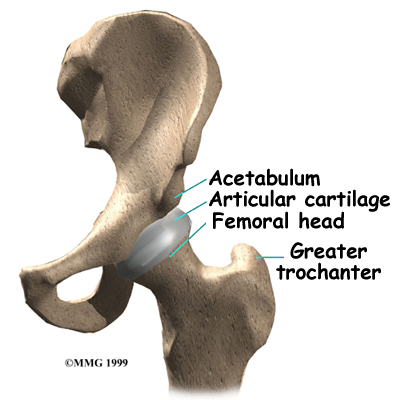
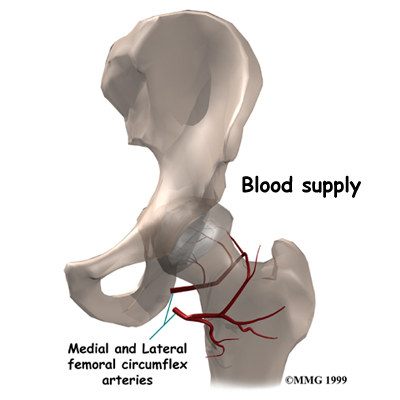
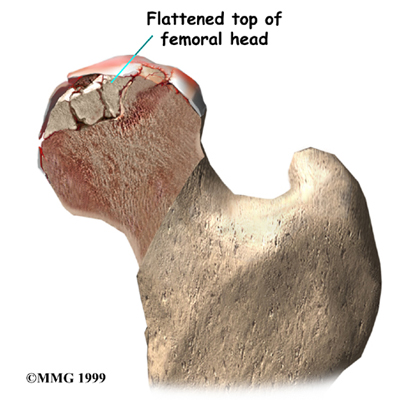 Living bone is always changing. To maintain a bone's strength, bone cells are constantly repairing the wear and tear that affects the bone tissue. If this process stops the bone can begin to weaken, just like rust can affect the metal structure of a bridge. Eventually, just like a rusty bridge, the bone structure begins to collapse.
Living bone is always changing. To maintain a bone's strength, bone cells are constantly repairing the wear and tear that affects the bone tissue. If this process stops the bone can begin to weaken, just like rust can affect the metal structure of a bridge. Eventually, just like a rusty bridge, the bone structure begins to collapse.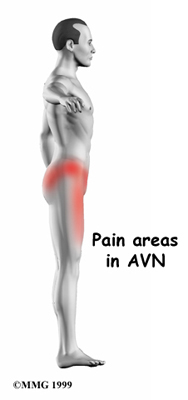
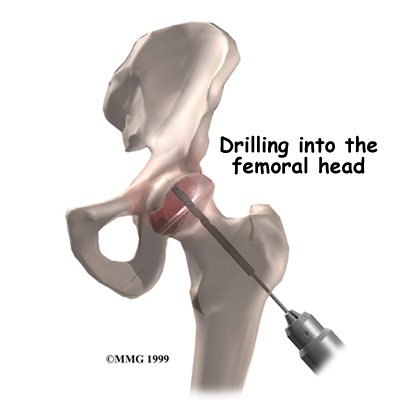 The simplest operation is to drill one or several holes through the femoral neck and into the femoral head, trying to reach the area that lacks blood supply. The drill bores out a plug of bone within the femoral head. This operation is thought to do two things: (1) it creates a channel for new blood vessels to quickly form into the area that lacks blood supply, and (2) it relieves some of the pressure inside the bone of the femoral head. Relieving this pressure seems to help decrease the pain patients experience from AVN.
The simplest operation is to drill one or several holes through the femoral neck and into the femoral head, trying to reach the area that lacks blood supply. The drill bores out a plug of bone within the femoral head. This operation is thought to do two things: (1) it creates a channel for new blood vessels to quickly form into the area that lacks blood supply, and (2) it relieves some of the pressure inside the bone of the femoral head. Relieving this pressure seems to help decrease the pain patients experience from AVN. A more complicated procedure to try to increase the blood supply to the femoral head is a vascularized fibular bone graft procedure. This is actually a tissue transplant rather than a classic bone graft. With this procedure the graft is taken from the fibula, which is the thin bone that runs next to the shin bone. The surgeon removes a piece of the small bone from the fibula along with the blood vessels to the bone. The surgeon then drills a hole through the side of the femur and into the femoral head. The surgeon attaches the blood vessels from the fibula to one of the blood vessels around the hip. This creates instant blood flow into the bone graft and into the head of the femur. This operation does two things: (1) it brings blood flow to the femoral head through the bone graft, and (2) because the fibular bone graft is strong, it keeps the femoral head from collapsing as the bone heals itself. Being that the graft supports the femoral head, the graft is also referred to as a strut graft. This procedure is an inpatient procedure and will require you to stay in the hospital for several days. It is a very complicated operation and is not commonly done. It is not always successful because the blood supply to the graft is fragile and may not form completely.
A more complicated procedure to try to increase the blood supply to the femoral head is a vascularized fibular bone graft procedure. This is actually a tissue transplant rather than a classic bone graft. With this procedure the graft is taken from the fibula, which is the thin bone that runs next to the shin bone. The surgeon removes a piece of the small bone from the fibula along with the blood vessels to the bone. The surgeon then drills a hole through the side of the femur and into the femoral head. The surgeon attaches the blood vessels from the fibula to one of the blood vessels around the hip. This creates instant blood flow into the bone graft and into the head of the femur. This operation does two things: (1) it brings blood flow to the femoral head through the bone graft, and (2) because the fibular bone graft is strong, it keeps the femoral head from collapsing as the bone heals itself. Being that the graft supports the femoral head, the graft is also referred to as a strut graft. This procedure is an inpatient procedure and will require you to stay in the hospital for several days. It is a very complicated operation and is not commonly done. It is not always successful because the blood supply to the graft is fragile and may not form completely.